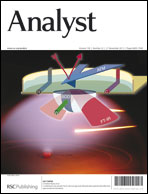Determination of aerosol oxidative activity using silver nanoparticle aggregation on paper-based analytical devices
Abstract
Airborne particulate matter (PM) pollution significantly impacts human health, but the cellular mechanisms of PM-induced toxicity remain poorly understood. A leading hypothesis on the effects of inhaled PM involves the generation of cellular oxidative stress. To investigate PM-induced oxidative stress, analytical methods have been developed to study the chemical oxidation of dithiothreitol (DTT) in the presence of PM. Although DTT readily reacts with several forms of reactive oxygen species, this molecule is not endogenously produced in biological systems. Glutathione (GSH), on the other hand, is an endogenous antioxidant that is produced throughout the body and is directly involved in combating oxidative stress in the lungs and other tissues. We report here a new method for measuring aerosol oxidative activity that uses silver nanoparticle (AgNP) aggregation coupled to glutathione (GSH) oxidation in a paper-based analytical device. In this assay, the residual reduced GSH from the oxidation of reduced GSH to its disulfide induces the aggregation of AgNPs on a paper-based analytical device, which produces a reddish-brown product. Two methods for aerosol oxidative reactivity are presented: one based on change in color intensity using a traditional paper-based techniques and one based on the length of the color product formed using a distance-based device. These methods were validated against traditional spectroscopic assays for DTT and GSH that employ Elman's reagent. No significant difference was found between the levels measured by all three GSH methods (our two paper-based devices and the traditional method) at the 95% confidence level. PM reactivity towards GSH was less than towards DTT most likely due to the difference in the oxidation potential between the two molecules.


 Please wait while we load your content...
Please wait while we load your content...